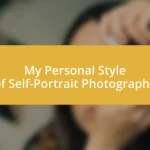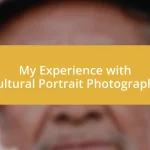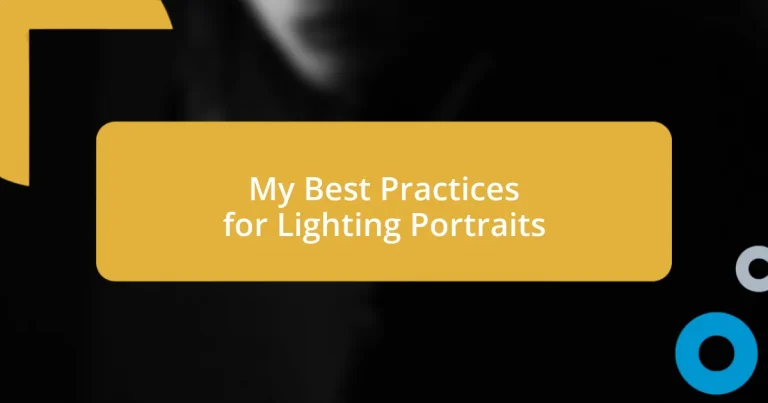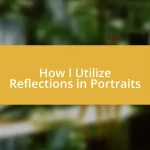Key takeaways:
- Understanding the quality, direction, and type of light transforms portraits, with soft light flattering and hard light adding drama.
- Proper positioning of lights and utilizing reflectors/diffusers enhance the emotional impact and clarity of portraits.
- Mastering natural light and experimenting with creative techniques, like backlighting and colored gels, unlocks unique artistic possibilities.
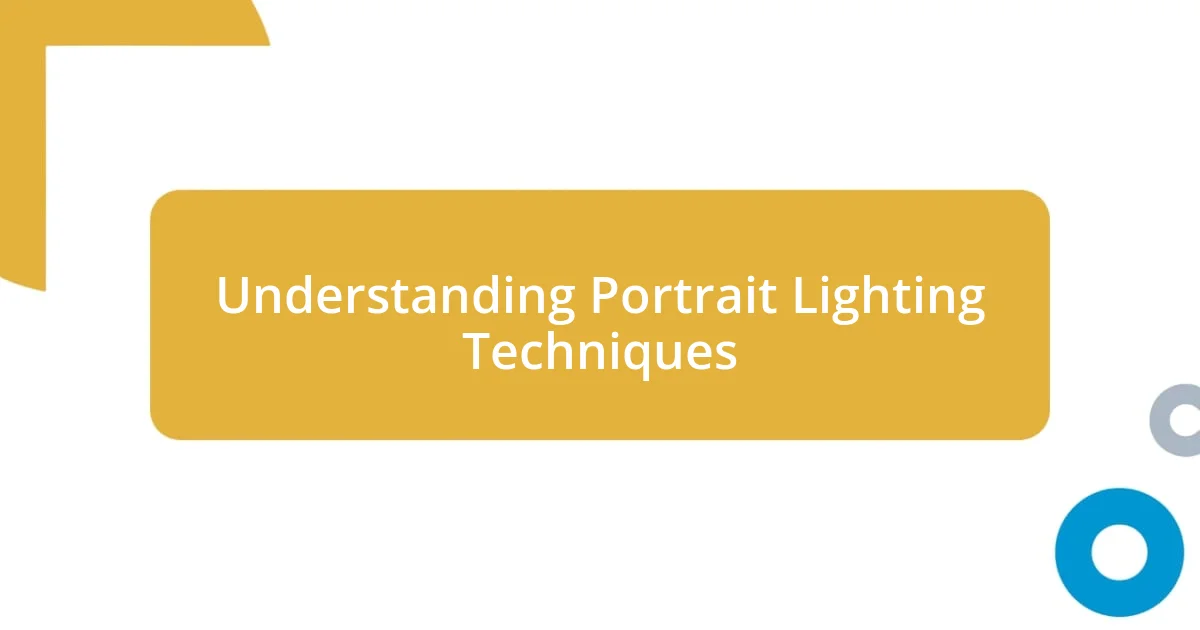
Understanding Portrait Lighting Techniques
Lighting is often the unsung hero of portrait photography. I remember one shoot where the light seemed flat and unappealing, which led to uninspired images. It dawned on me that understanding the direction and quality of light can make all the difference. Have you ever noticed how a simple shift in lighting can transform a mood?
Soft lighting creates a flattering effect, wrapping around features gently and diminishing shadows. I once experimented with window light during golden hour, and the results were magical; it added warmth and depth that truly captured the spirit of the person I was photographing. Have you ever felt the difference in ambiance when you switch from harsh midday sun to a soft, diffused light?
On the other hand, hard light can create striking, dramatic portraits, emphasizing textures and details. I recall a session where I used harsh light to highlight the rugged features of an older gentleman, and it told a story that soft light simply couldn’t deliver. Isn’t it fascinating how the same subject can evoke different emotions based solely on lighting choices? Understanding these techniques is crucial for any aspiring portrait photographer.
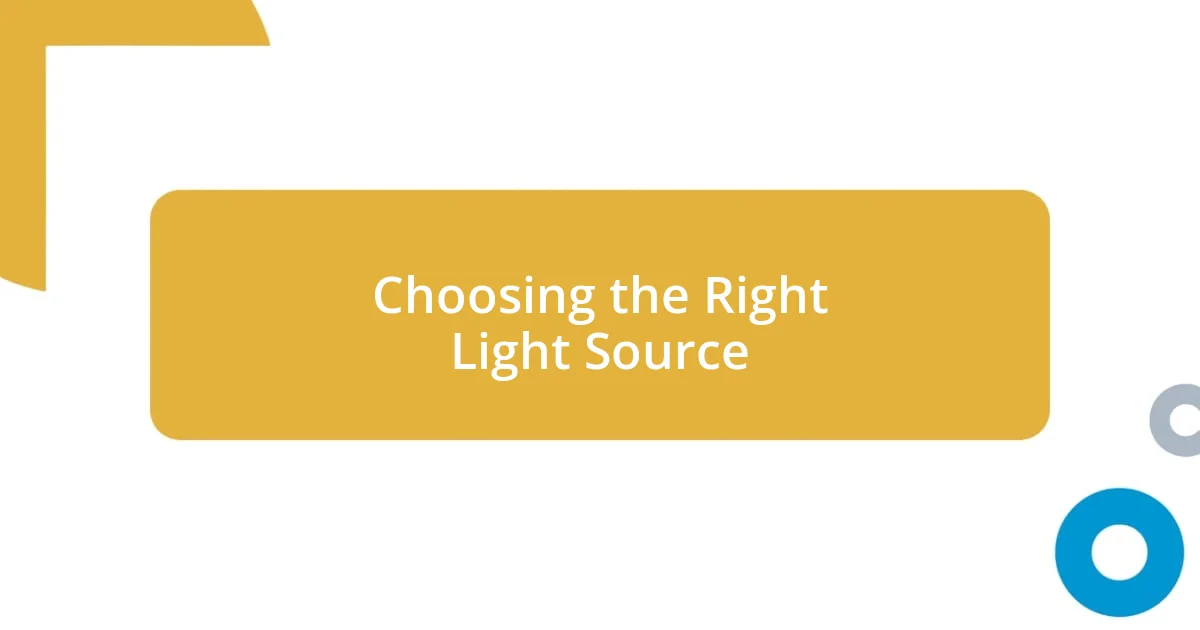
Choosing the Right Light Source
Choosing the right light source is fundamental to creating impactful portraits. I’ve found that natural light often delivers a unique softness, perfect for capturing a subject’s essence. On one occasion, I set up a shoot during an overcast day, and the light filtered in beautifully, creating a serene, almost ethereal vibe that felt deeply connected to the subject’s personality.
When considering light sources, here are key aspects I reflect on:
- Quality of Light: Soft vs. hard light can dramatically change the mood. Soft light flatters while hard light can create drama.
- Direction of Light: Front lighting can minimize imperfections, while side lighting enhances textures and creates depth.
- Type of Light Source: Natural, artificial, or a combination; I often mix them to achieve a distinctive look that resonates with the subject.
- Time of Day: Golden hour offers exquisite warmth, while midday sun can be harsh but can be creatively used with filters.
- Control Over Light: Using diffusers or reflectors gives you the power to manipulate the light to suit the shot.
Incorporating these elements has helped me develop a deeper understanding of how to utilize light to tell a story through my photographs.
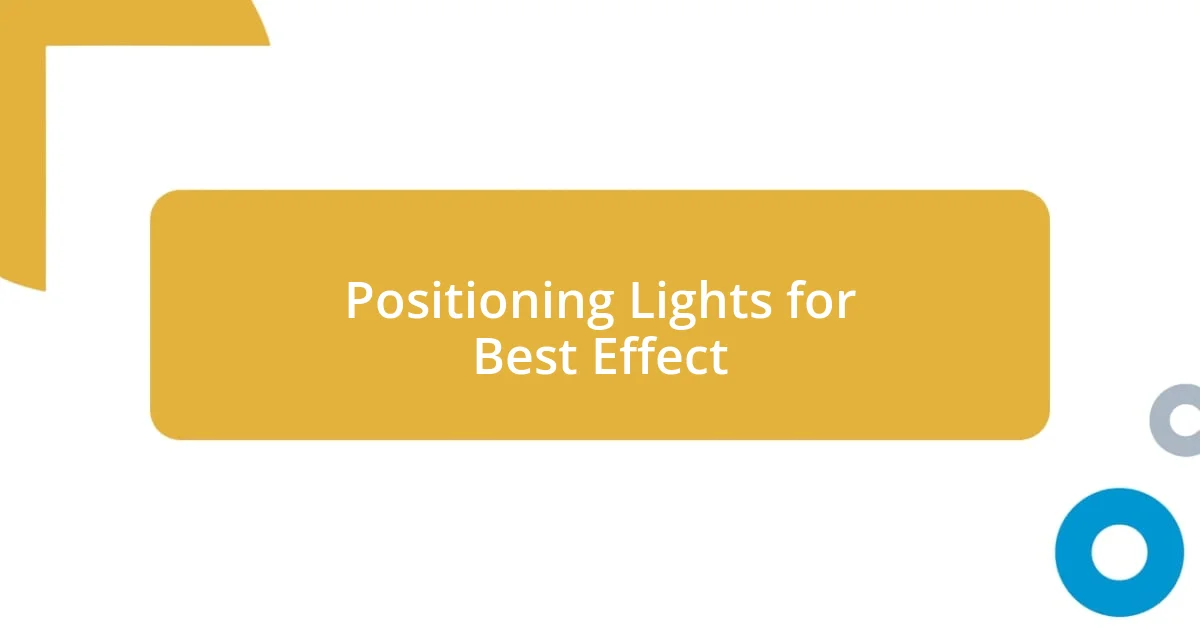
Positioning Lights for Best Effect
Positioning lights for the best effect hinges on understanding the relationship between light direction and subject. I once set up a portrait shoot where I placed my main light slightly above and to the side of my subject, which sculpted the face beautifully. I noticed that the angle created dynamic shadows, emphasizing the contours of her cheekbones. Have you tried adjusting your light to find that sweet spot? It can drastically enhance the emotional impact of your photo.
Then there’s the importance of distance. When I was photographing a couple, I positioned the softbox closer to them to create a warm, intimate atmosphere. The light wrapped around them softly, making their smiles appear even more genuine. Conversely, when I set the light further away, it became harsher, introducing sharp shadows that added a dramatic flair to the scene. Each distance creates a different mood, and it’s crucial to experiment with this.
Lastly, think about how the background interacts with the light. I remember a session where the backdrop transformed by merely adjusting the light’s angle. It shifted from a dull gray to a vibrant hue, enriching the overall image. The way light scatters can add layers of depth and context, and understanding this has been pivotal in enhancing my portraits. Have you observed how light can change an entire scene just by repositioning?
| Light Position | Effect |
|---|---|
| High and Side | Enhances features with dynamic shadows |
| Close and Soft | Creates warmth and clarity |
| Far and Harsh | Introduces drama and contrast |
| Background Interaction | Adds depth and context |
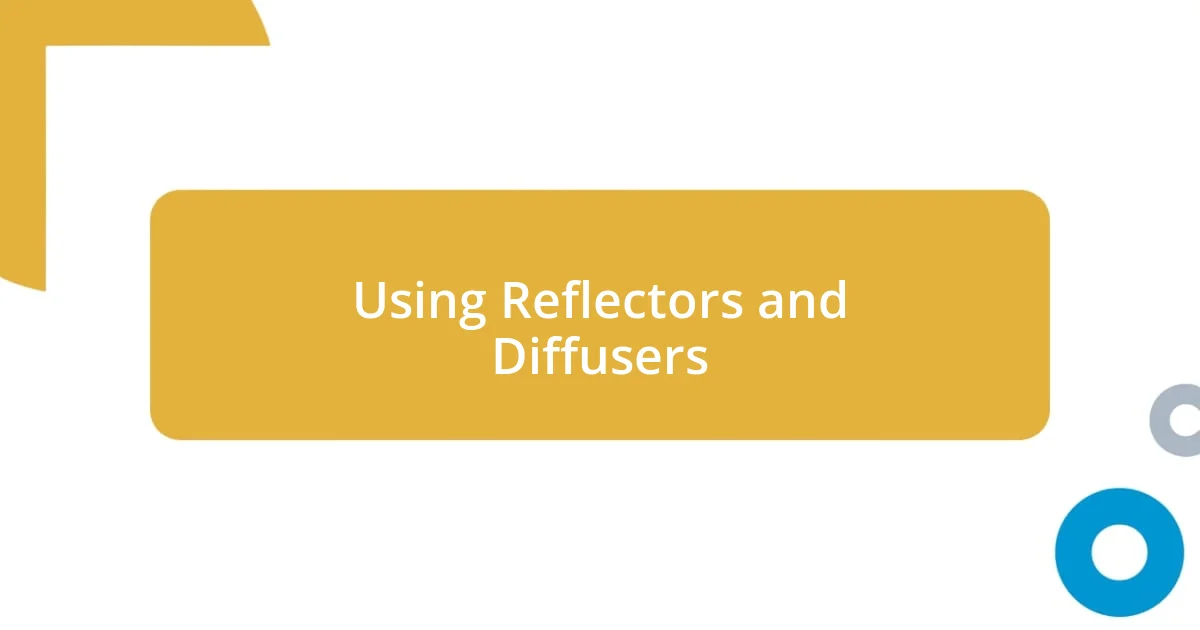
Using Reflectors and Diffusers
Using reflectors and diffusers can truly elevate your portrait lighting game. I remember one shoot where I utilized a silver reflector to bounce sunlight onto my subject’s face. The way it brightened her features was astounding and added a lovely sparkle to her eyes that I’d never achieved before. Have you ever noticed how a simple reflection can bring life to a still image? It’s almost magical!
Diffusers play a similar role in softening harsh light. I once shot outdoors under a blazing sun, and the light was so intense that it cast strong shadows. By placing a translucent diffuser between the sun and my subject, I softened the light beautifully. Suddenly, the shadows became gentle, and the overall mood shifted to a soothing, almost dreamlike quality. It was a clear reminder that controlling light is essential to storytelling in photography.
Choosing the right reflector or diffuser is also about understanding their different effects. A white reflector can warm up the light, while a gold one adds a sun-kissed glow. I experimented with various types during a shoot with a musician; the gold reflector turned a regular portrait into something that felt vibrant and alive, echoing the artist’s personality. Which effect resonates with you the most in your work? Discovering the nuances of these tools has made a significant difference in how I visualize and create portraits.
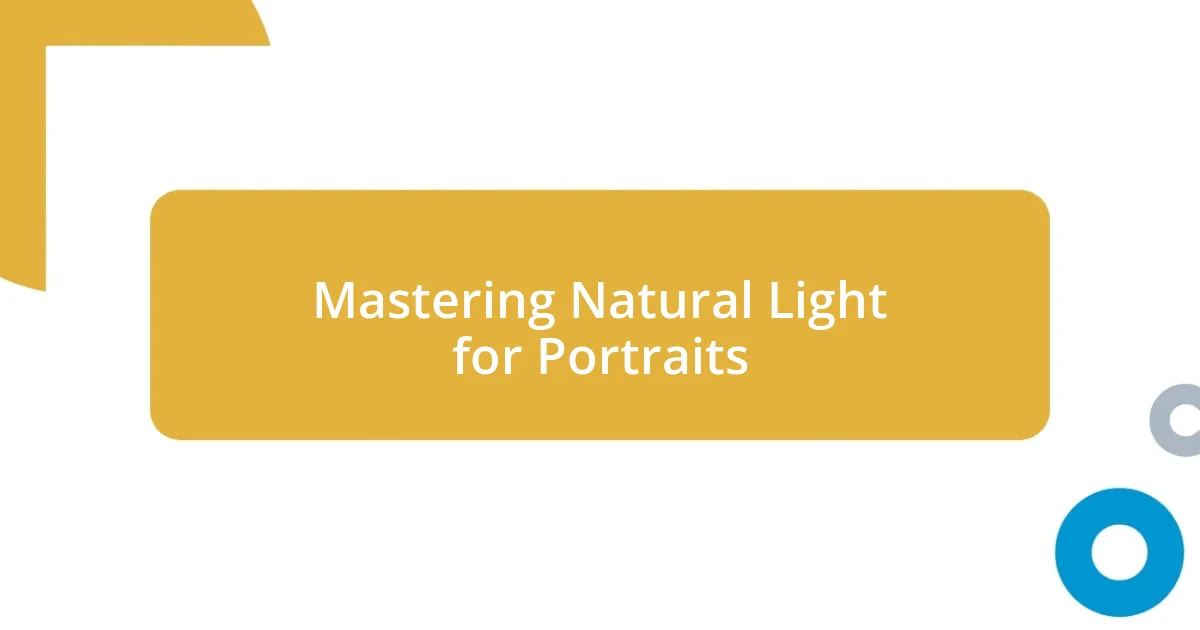
Mastering Natural Light for Portraits
Mastering natural light is about embracing its changing qualities throughout the day. Reflecting on my experience, I remember a golden hour shoot that took my breath away. The warm light draped my subject in a soft glow, making every feature look ethereal. That specific time, just before sunset, transformed an ordinary portrait into an unforgettable memory. Have you ever experienced the magic of that fleeting light?
Positioning your subject in relation to the light can also bring out the best in your portraits. On one occasion, I had my friend pose under a large tree while the sun streamed through the leaves. The dappled light created fascinating patterns on her face, adding texture and depth to the shot. This interplay between light and shadow is a beautiful dance that can bring your images to life. What unique effects have you discovered in using natural light?
It’s incredible how shifting your perspective, even slightly, can change everything. During a recent session at the beach, I found that by changing my shooting angle just a bit, the sunlight reflected off the water and illuminated my subject in unexpected ways. It not only highlighted her features but also hinted at the vibrant atmosphere around us. Have you considered how slight adjustments can unlock new possibilities in your work? Embracing these nuances of natural light is where the true artistry lies.
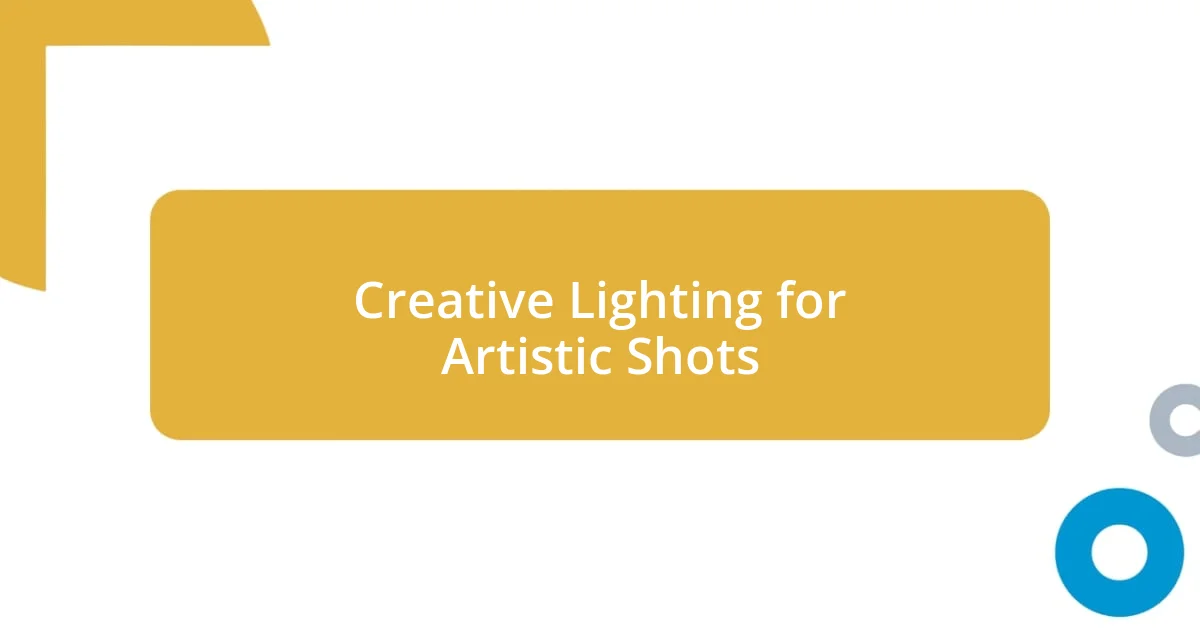
Creative Lighting for Artistic Shots
Creative lighting can dramatically transform your artistic shots, and it’s an opportunity to express your unique vision. I vividly recall a session where I decided to experiment with colored gels on my lights. As I shifted hues, my model morphed from a serene figure into a vibrant character from a dream. Isn’t it fascinating how mere colors can evoke different emotions and stories? That shoot convinced me that playing with lighting could unlock unparalleled creativity.
Using backlighting is another technique I’ve come to appreciate deeply. During a whimsical shoot in a sunflower field, I positioned the sun right behind my subject. This created a radiant halo effect that illuminated her hair like spun gold, framing her in such a ethereal glow. Moments like this remind me of the enchantment that can emerge from a simple change in lighting direction. Have you explored the ways backlighting can shape the narrative of your photos?
One time, I aimed a spotlight at my subject and used shadows to craft an almost theatrical atmosphere. It was a breathtaking contrast that brought out dramatic angles and highlighted the subject’s expression beautifully. That experience solidified my belief that shadows are just as powerful as light. Have you ever considered how embracing darkness can add layers to your portraits? The dance between light and shadow is where creativity thrives, and I urge you to explore it in your own practice.
